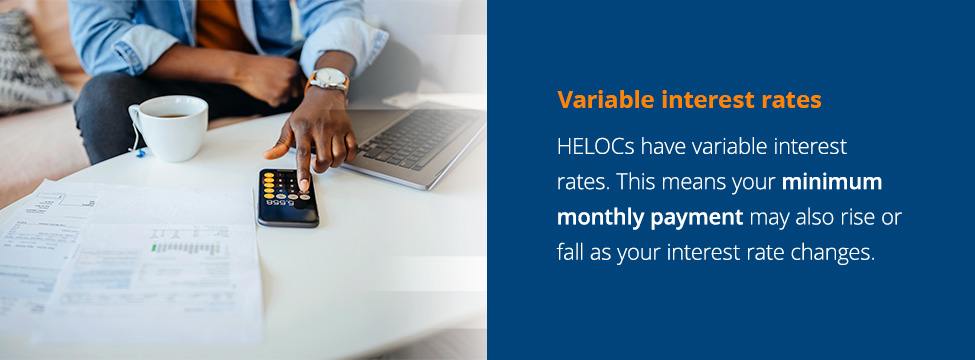Top Five Things You Should Know About Home Equity Lines of Credit

A home equity line of credit (HELOC) is one way to tap into your home’s equity. This option tends to become more popular as interest rates rise and other options become less appealing.
If you are considering a HELOC, you may first want to evaluate the current market rates and determine how you want to use your funds if you qualify for a HELOC. This article covers what a HELOC is, whether applying for one is a good idea for you, what you need to know about HELOCs, and some frequently asked questions regarding this financing option.
What Is a HELOC?
HELOCs are an alternative to traditional loans and are designed to serve a qualified homeowner’s needs. You can use a HELOC to pay for large one-time or ongoing expenses, such as home renovations or college expenses.
With a HELOC, you borrow against your line of credit up to the limit and then pay back the amount you owe. You also don’t have to use your HELOC right away, keeping the credit line open for future purchases or emergencies. When you have a HELOC, you can access your funds easily by simply transferring money online or writing a check.
How Does a HELOC Work?
Think of a HELOC as similar to a credit card but with your home issued as collateral. This revolving line of credit allows you to borrow up to your predetermined credit limit. As with a credit card, you can borrow money as needed, and you don’t need to borrow a large lump sum. Additionally, you pay interest only on the amount you borrow versus the unused credit limit.
Is Getting a HELOC a Good Idea?
Whether a HELOC is a good idea for you or not depends on your plans for the funds, your credit score, and the interest rate you may qualify for. If you want to complete a home renovation and you qualify for a low interest rate, a HELOC could be an excellent option. If you want to take a vacation, using your home as collateral with a HELOC may not be the best option.
Pros and Cons of Home Equity Line of Credit
To determine whether a HELOC is a good idea for you, you should first consider the pros and cons of this credit line. The following are some of the advantages of obtaining a HELOC:
- Borrow only as you need funds
- Interest on your tax return may be deducted
- Get lower interest rates than a credit card
- Use your funds as you see fit with few limitations
- Improve your credit score with on-time payments
- Pay back your funds with flexible repayment terms
There are also some disadvantages of HELOCs to consider, such as:
- You may risk overspending
- Your interest rate may rise and increase your payments
- You may reduce the equity you have built up in your home
- You may risk losing your home when you use it as collateral
Five Things to Know About HELOCs

Here are five essential aspects to know about HELOCs:
- Variable interest rates: HELOCs have variable interest rates. Unlike a fixed interest rate, a variable interest rate could increase or decrease. This means your minimum monthly payment may also rise or fall as your interest rate changes. In some cases, you may have the option to convert your HELOC balance into a loan with a fixed rate.
- Borrowing timeframe: You can borrow money with a HELOC for a certain period. This timeframe is known as the draw period, during which you will have a few years to borrow money. Your draw period can vary depending on your lender and your needs.
- Equity affects credit limit: Your credit limit will vary depending on your home equity. Your equity is the value of your home minus what you owe. You may borrow a certain percentage of your equity, depending on your lenders underwriting guidelines.
- Fees: You may also need to pay fees if you obtain a HELOC, such as an appraisal fee, application fee, annual fee, draw fee, inactivity fee, cancellation fee, and closing costs.
- Draw and repayment periods: The two main periods are known as draw and repayment. During the draw period, you can borrow against your credit line. Your payments during this time are interest-only. After the draw period ends, you enter the repayment period. During this period, you cannot borrow from your line of credit, and you’ll pay back the principal and interest.
Home Equity Line of Credit FAQs
If you would like further information about HELOCs, we answer some frequently asked questions below.
Do You Have to Pay a HELOC Back?
Yes, you do have to pay a HELOC back. During the draw period, you will make interest-only payments. During the repayment period, you will make principal-plus-interest payments. Since your home is collateral, if you don’t pay your HELOC back, you could risk foreclosure on your home. Speak with your lender if you are concerned about paying back your HELOC.
What Is the Best Way to Get Equity Out of Your Home?
A HELOC is one of the best ways to get equity out of your home. To leverage your equity, you first need to build equity in your home. You build up equity by making a down payment and paying down the principal balance on your mortgage. You can also build equity when your home increases in value.
What Credit Score Do You Need to Take Out a Home Equity Loan?
Your credit score often affects whether you qualify for a loan, including Home Equity Loans. Along with whether you qualify, your credit score can impact your interest rate. Typically, the higher your credit score, the better rates and terms you receive.
Contact Us at Mid Penn Bank
At Mid Penn Bank, we are a community bank committed to providing personalized service, local community support, and comprehensive financial solutions. Mid Penn Bank was founded in Pennsylvania in 1868. We have since expanded to operate statewide as a full-service financial institution and have more than 44 financial centers. We offer our personalized service to individuals, nonprofits and businesses. In addition to home equity loans and HELOCs, our services and solutions include mortgages and checking and savings accounts.
If you’re still unsure whether a HELOC or home equity loan is a good choice for you, contact us at Mid Penn Bank to learn more.
Share:
Disclosures
The material on this site was created for educational purposes. It is not intended to be and should not be treated as legal, tax, investment, accounting, or other professional advice.
Securities and Insurance Products:
NOT A DEPOSIT | NOT FDIC INSURED | NOT BANK GUARANTEED | NOT INSURED BY ANY FEDERAL GOVERNMENT AGENCY | MAY LOSE VALUE

